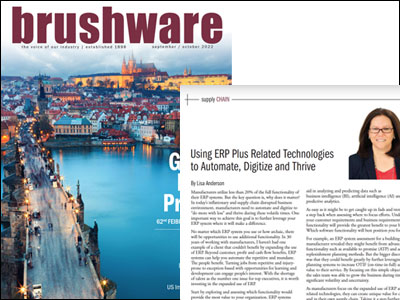Manufacturers utilize less than 20% of the full functionality of their ERP systems. But the key question is, why does it matter? In today’s inflationary and supply chain disrupted business environment, manufacturers need to automate and digitize to ‘do more with less’ and thrive during these volatile times. One important way to achieve this goal is to further leverage your ERP system where it will make a difference.
No matter which ERP system you use or how archaic, there will be opportunities to use additional functionality. In 30 years of working with manufacturers, there hasn’t been one example of a client that couldn’t benefit by expanding the use of ERP. Beyond customer, profit, and cash flow benefits, ERP systems can help you automate the repetitive and mundane. The people benefit. Turning jobs from repetitive and injury-prone to exception-based with opportunities for learning and development can engage people’s interest. With the shortage of talent as the number one issue to top executives, it is worth investing in the expanded use of ERP.
Start by exploring and assessing which functionality would provide the most value to your organization. ERP systems support your order to delivery cycle, which is essential to successfully fulfilling your sales order demand, improving delivery performance, and reducing lead times. ERP functionality also supports the procure to pay cycle, which is key to purchasing the right materials to arrive at the right place at the right time to support manufacturing and most efficiently manage inventory levels. Almost every client can improve upon the plan to produce cycle, which can achieve three objectives simultaneously – improved customer service, increased efficiencies, and accelerated working capital.
Beyond base ERP, there are many technologies that support the customer such as customer relationship management (CRM), sales forecasting, and e-commerce. Additionally, there are software options to automate and digitize for increased efficiencies and improved quality standards such as the use of barcoding, RFID (radio frequency identification), robotics, autonomous vehicles, digital twins, and automated storage and retrieval systems. Critically important are software options to aid in analyzing and predicting data such as business intelligence (BI), artificial intelligence (AI), and predictive analytics.
As easy as it might be to get caught up in fads and trends, take a step back when assessing where to focus efforts. Understand your customer requirements and business requirements. Which functionality will provide the greatest benefit to your business? Which software functionality will best position you for growth?
For example, in a building products manufacturer, an assessment was completed of their use of their ERP system. Although they might benefit from advanced functionality such as available to promise (ATP) and advanced replenishment planning methods, they discovered they could benefit greatly by simply further leveraging their planning systems to increase OTIF (on-time-in-full) and add value to their service. By focusing on this simple objective, the sales team was able to grow the business during times of significant volatility and uncertainty.
As manufacturers focus on the expanded use of ERP and related technologies, they can create unique value for customers and in their supply chain. Taking it a step further, to thrive during these inflationary times, it is important to automate, digitize, reduce repetitive labor requirements, increase efficiencies, and standardize so that more can be achieved with less. Create value by better utilizing your already-existing ERP asset and engaging your people in solutions and progress.
As originally published in Brushware Magazine on September-October, 2022



